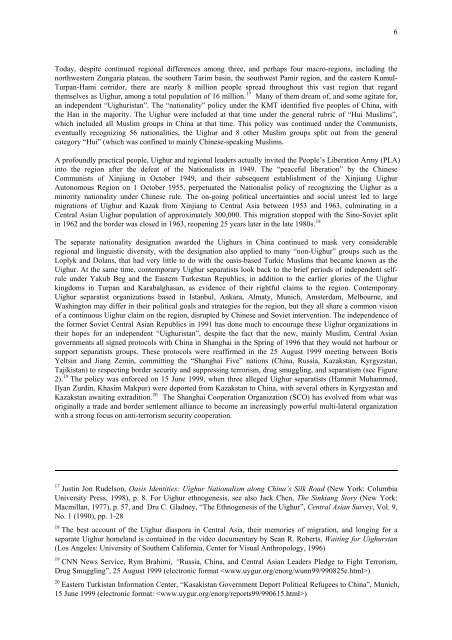Dru C. Gladney, Ph.D. - House Foreign Affairs Committee Democrats
Dru C. Gladney, Ph.D. - House Foreign Affairs Committee Democrats
Dru C. Gladney, Ph.D. - House Foreign Affairs Committee Democrats
You also want an ePaper? Increase the reach of your titles
YUMPU automatically turns print PDFs into web optimized ePapers that Google loves.
6<br />
Today, despite continued regional differences among three, and perhaps four macro-regions, including the<br />
northwestern Zungaria plateau, the southern Tarim basin, the southwest Pamir region, and the eastern Kumul-<br />
Turpan-Hami corridor, there are nearly 8 million people spread throughout this vast region that regard<br />
themselves as Uighur, among a total population of 16 million. 17 Many of them dream of, and some agitate for,<br />
an independent “Uighuristan”. The “nationality” policy under the KMT identified five peoples of China, with<br />
the Han in the majority. The Uighur were included at that time under the general rubric of “Hui Muslims”,<br />
which included all Muslim groups in China at that time. This policy was continued under the Communists,<br />
eventually recognizing 56 nationalities, the Uighur and 8 other Muslim groups split out from the general<br />
category “Hui” (which was confined to mainly Chinese-speaking Muslims.<br />
A profoundly practical people, Uighur and regional leaders actually invited the People’s Liberation Army (PLA)<br />
into the region after the defeat of the Nationalists in 1949. The “peaceful liberation” by the Chinese<br />
Communists of Xinjiang in October 1949, and their subsequent establishment of the Xinjiang Uighur<br />
Autonomous Region on 1 October 1955, perpetuated the Nationalist policy of recognizing the Uighur as a<br />
minority nationality under Chinese rule. The on-going political uncertainties and social unrest led to large<br />
migrations of Uighur and Kazak from Xinjiang to Central Asia between 1953 and 1963, culminating in a<br />
Central Asian Uighur population of approximately 300,000. This migration stopped with the Sino-Soviet split<br />
in 1962 and the border was closed in 1963, reopening 25 years later in the late 1980s. 18<br />
The separate nationality designation awarded the Uighurs in China continued to mask very considerable<br />
regional and linguistic diversity, with the designation also applied to many “non-Uighur” groups such as the<br />
Loplyk and Dolans, that had very little to do with the oasis-based Turkic Muslims that became known as the<br />
Uighur. At the same time, contemporary Uighur separatists look back to the brief periods of independent selfrule<br />
under Yakub Beg and the Eastern Turkestan Republics, in addition to the earlier glories of the Uighur<br />
kingdoms in Turpan and Karabalghasan, as evidence of their rightful claims to the region. Contemporary<br />
Uighur separatist organizations based in Istanbul, Ankara, Almaty, Munich, Amsterdam, Melbourne, and<br />
Washington may differ in their political goals and strategies for the region, but they all share a common vision<br />
of a continuous Uighur claim on the region, disrupted by Chinese and Soviet intervention. The independence of<br />
the former Soviet Central Asian Republics in 1991 has done much to encourage these Uighur organizations in<br />
their hopes for an independent “Uighuristan”, despite the fact that the new, mainly Muslim, Central Asian<br />
governments all signed protocols with China in Shanghai in the Spring of 1996 that they would not harbour or<br />
support separatists groups. These protocols were reaffirmed in the 25 August 1999 meeting between Boris<br />
Yeltsin and Jiang Zemin, committing the “Shanghai Five” nations (China, Russia, Kazakstan, Kyrgyzstan,<br />
Tajikistan) to respecting border security and suppressing terrorism, drug smuggling, and separatism (see Figure<br />
2). 19 The policy was enforced on 15 June 1999, when three alleged Uighur separatists (Hammit Muhammed,<br />
Ilyan Zurdin, Khasim Makpur) were deported from Kazakstan to China, with several others in Kyrgyzstan and<br />
Kazakstan awaiting extradition. 20 The Shanghai Cooperation Organization (SCO) has evolved from what was<br />
originally a trade and border settlement alliance to become an increasingly powerful multi-lateral organization<br />
with a strong focus on anti-terrorism security cooperation.<br />
17 Justin Jon Rudelson, Oasis Identities: Uighur Nationalism along China’s Silk Road (New York: Columbia<br />
University Press, 1998), p. 8. For Uighur ethnogenesis, see also Jack Chen, The Sinkiang Story (New York:<br />
Macmillan, 1977), p. 57, and <strong>Dru</strong> C. <strong>Gladney</strong>, “The Ethnogenesis of the Uighur”, Central Asian Survey, Vol. 9,<br />
No. 1 (1990), pp. 1-28<br />
18 The best account of the Uighur diaspora in Central Asia, their memories of migration, and longing for a<br />
separate Uighur homeland is contained in the video documentary by Sean R. Roberts, Waiting for Uighurstan<br />
(Los Angeles: University of Southern California, Center for Visual Anthropology, 1996)<br />
19 CNN News Service, Rym Brahimi, “Russia, China, and Central Asian Leaders Pledge to Fight Terrorism,<br />
<strong>Dru</strong>g Smuggling”, 25 August 1999 (electronic format )<br />
20 Eastern Turkistan Information Center, “Kasakistan Government Deport Political Refugees to China”, Munich,<br />
15 June 1999 (electronic format: )











![Transcript [PDF] - House Foreign Affairs Committee Democrats](https://img.yumpu.com/34524080/1/190x245/transcript-pdf-house-foreign-affairs-committee-democrats.jpg?quality=85)



